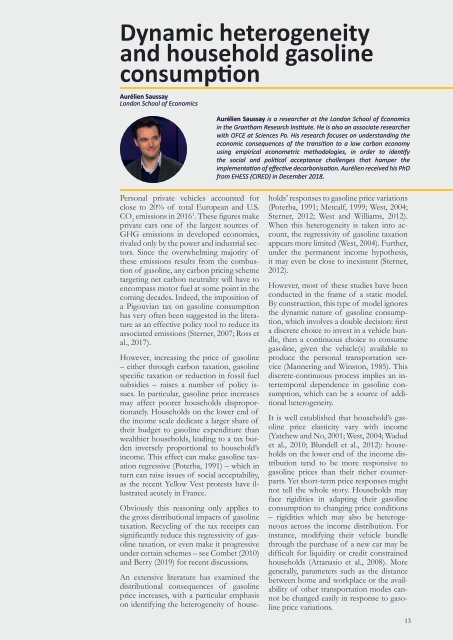EAERE Magazine - n.7 Fall 2019
Create successful ePaper yourself
Turn your PDF publications into a flip-book with our unique Google optimized e-Paper software.
Dynamic heterogeneity<br />
and household gasoline<br />
consumption<br />
Aurélien Saussay<br />
London School of Economics<br />
Aurélien Saussay is a researcher at the London School of Economics<br />
in the Grantham Research Institute. He is also an associate researcher<br />
with OFCE at Sciences Po. His research focuses on understanding the<br />
economic consequences of the transition to a low carbon economy<br />
using empirical econometric methodologies, in order to identify<br />
the social and political acceptance challenges that hamper the<br />
implementation of effective decarbonisation. Aurélien received his PhD<br />
from EHESS (CIRED) in December 2018.<br />
Personal private vehicles accounted for<br />
close to 20% of total European and U.S.<br />
CO 2<br />
emissions in 2016 1 . These figures make<br />
private cars one of the largest sources of<br />
GHG emissions in developed economies,<br />
rivaled only by the power and industrial sectors.<br />
Since the overwhelming majority of<br />
these emissions results from the combustion<br />
of gasoline, any carbon pricing scheme<br />
targeting net carbon neutrality will have to<br />
encompass motor fuel at some point in the<br />
coming decades. Indeed, the imposition of<br />
a Pigouvian tax on gasoline consumption<br />
has very often been suggested in the literature<br />
as an effective policy tool to reduce its<br />
associated emissions (Sterner, 2007; Ross et<br />
al., 2017).<br />
However, increasing the price of gasoline<br />
– either through carbon taxation, gasoline<br />
specific taxation or reduction in fossil fuel<br />
subsidies – raises a number of policy issues.<br />
In particular, gasoline price increases<br />
may affect poorer households disproportionately.<br />
Households on the lower end of<br />
the income scale dedicate a larger share of<br />
their budget to gasoline expenditure than<br />
wealthier households, leading to a tax burden<br />
inversely proportional to household’s<br />
income. This effect can make gasoline taxation<br />
regressive (Poterba, 1991) – which in<br />
turn can raise issues of social acceptability,<br />
as the recent Yellow Vest protests have illustrated<br />
acutely in France.<br />
Obviously this reasoning only applies to<br />
the gross distributional impacts of gasoline<br />
taxation. Recycling of the tax receipts can<br />
significantly reduce this regressivity of gasoline<br />
taxation, or even make it progressive<br />
under certain schemes – see Combet (2010)<br />
and Berry (<strong>2019</strong>) for recent discussions.<br />
An extensive literature has examined the<br />
distributional consequences of gasoline<br />
price increases, with a particular emphasis<br />
on identifying the heterogeneity of households’<br />
responses to gasoline price variations<br />
(Poterba, 1991; Metcalf, 1999; West, 2004;<br />
Sterner, 2012; West and Williams, 2012).<br />
When this heterogeneity is taken into account,<br />
the regressivity of gasoline taxation<br />
appears more limited (West, 2004). Further,<br />
under the permanent income hypothesis,<br />
it may even be close to inexistent (Sterner,<br />
2012).<br />
However, most of these studies have been<br />
conducted in the frame of a static model.<br />
By construction, this type of model ignores<br />
the dynamic nature of gasoline consumption,<br />
which involves a double decision: first<br />
a discrete choice to invest in a vehicle bundle,<br />
then a continuous choice to consume<br />
gasoline, given the vehicle(s) available to<br />
produce the personal transportation service<br />
(Mannering and Winston, 1985). This<br />
discrete-continuous process implies an intertemporal<br />
dependence in gasoline consumption,<br />
which can be a source of additional<br />
heterogeneity.<br />
It is well established that household’s gasoline<br />
price elasticity vary with income<br />
(Yatchew and No, 2001; West, 2004; Wadud<br />
et al., 2010; Blundell et al., 2012): households<br />
on the lower end of the income distribution<br />
tend to be more responsive to<br />
gasoline prices than their richer counterparts.<br />
Yet short-term price responses might<br />
not tell the whole story. Households may<br />
face rigidities in adapting their gasoline<br />
consumption to changing price conditions<br />
– rigidities which may also be heterogeneous<br />
across the income distribution. For<br />
instance, modifying their vehicle bundle<br />
through the purchase of a new car may be<br />
difficult for liquidity or credit constrained<br />
households (Attanasio et al., 2008). More<br />
generally, parameters such as the distance<br />
between home and workplace or the availability<br />
of other transportation modes cannot<br />
be changed easily in response to gasoline<br />
price variations.<br />
13<br />
13













